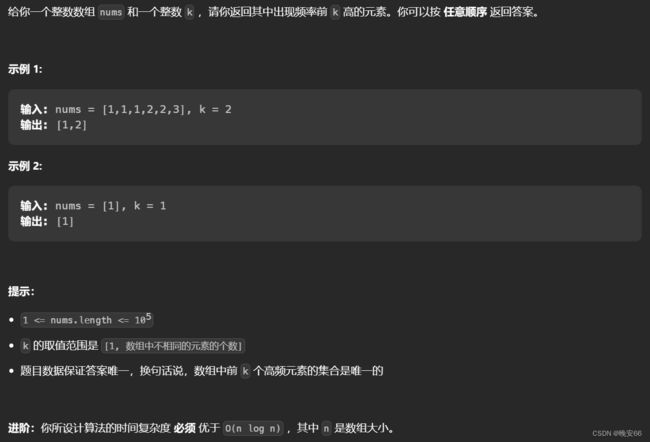【算法和数据结构】347、LeetCode前 K 个高频元素
文章目录
- 一、题目
- 二、解法
- 三、完整代码
所有的LeetCode题解索引,可以看这篇文章——【算法和数据结构】LeetCode题解。
一、题目
二、解法
思路分析:首先我们使用一个哈希表记录每个元素出现的频率。再设置一个优先队列,并将数组中元素出现的频率和该元素依次加入到优先队列。由于优先队列会自动进行排序,所以此时优先队列中存储的值就是按照频率进行排序的。注意排序是按照对组的第一个元素进行,插入优先队列后,对组的first代表元素频率,对组的second代表插入的元素。最后设置一个结果数组,再根据题目中的要求向数组中压入需要的k个最大频率的元素即可。
程序如下:
vector<int> topKFrequent(vector<int>& nums, int k) {
unordered_map<int, int> m;
for (int num : nums) m[num]++; // 记录元素出现频率,num代表元素,value代表出现的频率
priority_queue<pair<int, int>> que;
for (auto i : m) que.emplace(i.second, i.first); // 降序排列,大根堆,频次最高的元素在队头
vector<int> result(k);
while (!que.empty() && k--) {
result.emplace_back(que.top().second);
que.pop();
}
return result;
}
复杂度分析:
- 时间复杂度: O ( n ∗ l o g n ) O(n*logn) O(n∗logn)。记录元素出现频率需要的复杂度为 O ( n ) O(n) O(n),然后遍历频率数组复杂度为 O ( n ) O(n) O(n),其中优先级队列又要插入频率数组,大顶堆的插入操作复杂度为 O ( l o g n ) O(log n) O(logn),最后向结果数组插入k个最大元素,复杂度为 O ( k ) O(k) O(k)。总复杂度为 O ( n + n ∗ l o g n + k ) = O ( n ∗ l o g n ) O(n + n*log n + k)=O(n*logn) O(n+n∗logn+k)=O(n∗logn)。
- 空间复杂度: O ( n ) O(n) O(n)。
代码优化:这道题的时间复杂度还可以进一步优化。我们首先要意识到目标是最大的K个频率的元素,因此没有必要将所有的元素都插进优先队列当中,仅仅需要插入K个最大出现频率的元素即可。那么需要与已经插入的K个元素进行对比,此时大根堆就不在适用了,找到最小的值就很困难。因此我们使用小根堆,如果插入元素大于堆顶(小根堆,最小元素),那么插入元素,同时弹出堆顶。使用这种方式只需要维护K个元素的优先级队列,插入的次数也仅仅为 O ( l o g k ) O(log k) O(logk),因此总时间复杂度为 O ( n ∗ l o g k ) O(n*logk) O(n∗logk)。
程序如下:
vector<int> topKFrequent2(vector<int>& nums, int k) {
class mycomparison { // 为小顶堆提供比较函数
public:
bool operator()(const pair<int, int>& lhs, const pair<int, int>& rhs) {
return lhs.second > rhs.second;
}
};
unordered_map<int, int> m;
for (int num : nums) m[num]++; // 记录元素出现频率,key/num代表元素,value代表出现的频率
priority_queue<pair<int, int>, vector<pair<int, int>>, mycomparison> que;
for (unordered_map<int, int>::iterator it = m.begin(); it != m.end(); it++) {
que.push(*it);
if (que.size() > k) { // 如果堆的大小大于了K,则队列弹出,保证堆的大小一直为k
que.pop();
}
}
vector<int> result(k); // 向结果数组中插入K个最大元素
for (int i = k - 1; i >= 0; i--) {
result[i] = que.top().first;
que.pop();
}
return result;
}
三、完整代码
# include end
